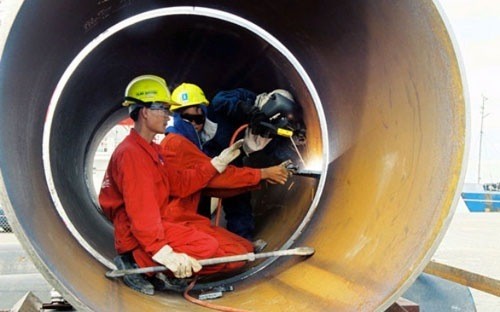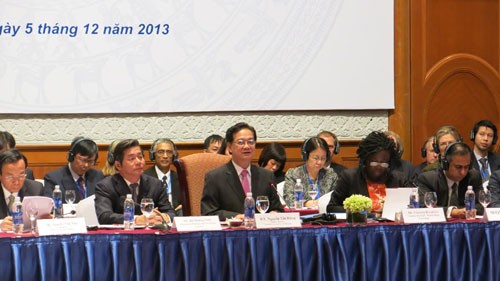 Although by August the PM approved 100 out of 101 plans to restructure state-owned enterprises of ministries and provinces for the 2011-2015 period, the implementation remains inefficient and incoherent, according to the NA’s Economic Committee. (Photo: VIR)
Although by August the PM approved 100 out of 101 plans to restructure state-owned enterprises of ministries and provinces for the 2011-2015 period, the implementation remains inefficient and incoherent, according to the NA’s Economic Committee. (Photo: VIR)
(VOVworld) – The Vietnamese government’s management efforts in 2013 have led to its economic restructuring achieving initial results and increasing the economy’s efficiency. VOV’s To Tuan reviews the process.
In 2013, the Vietnamese government has focused its economic restructuring master plan on improving institutions and policies and reforming the growth model. Top-priority fields include public investment, financial and credit organizations, and state-owned enterprises.
2013 is the first year the Ministry of Industry and Trade has implemented a government resolution on restructuring state-owned corporations and economic groups. The plan to restructure state enterprises emphasizes on key sectors, essential public services, national security, and defense. Following the roadmap, the Ministry has clearly defined functions and withdrawn investment capital from areas outside the core businesses of state-owned corporations and economic groups. Minister Vu Huy Hoang says:
“The Ministry of Industry and Trade has implemented the government’s directive to restructure enterprises and ensure the rights and responsibility of the state owner in economic groups, corporations, and companies under the Ministry’s management. In a number of areas, studies are continuing before new restructuring policies are promulgated to ensure the efficiency of SOEs.”
The efforts have initially improved the efficiency of state-owned enterprises. To date, about 80% of SOEs have made profits totaling 33% of GDP.
Regarding investment restructuring, especially public investment, the government has directed the adjustment and allocation of investment capital for key projects and counterpart capital for ODA-funded projects. Control has been tightened for newly-launched projects while scattered investment has gradually been eliminated. A mechanism of investment management decentralization is being improved to increase responsibility of provincial authorities and investors while private investment is enhanced. So far, the level of non-state investment has increased to 62.6% in the 2011-2013 period from 61.3% of 5 years ago.
Initial results have been recorded in implementing comprehensive measures to restructure credit institutions. Weak banks have been restructured. Four state commercial banks have been equitized. Bad debts have gradually been checked, with the monthly rate increasing by 2.5% over the past 8 months, a remarkable decline compared to the 3.9% level of the same period last year.
A plan to restructure the agricultural sector towards greater added value and sustainable development has been implemented. It focuses on transforming crop and animal structures, promoting the application of technology, building large-scale industrial crop zones and high-tech agricultural zones, linking production with processing, preservation and distribution, and integrating into the global production network and value chain.
 Prime Minister Nguyen Tan Dung at a recent Vietnam Development Partnership Forum in Hanoi.
Prime Minister Nguyen Tan Dung at a recent Vietnam Development Partnership Forum in Hanoi.
The government’s implementation of plans to restructure the entire economy has remarkably improved the economy at both macro and micro levels. But generally, Vietnam’s socio-economic development is still facing many challenges, particularly a slow growth rate. At the recent Vietnam Development Partnership Forum in Hanoi, Prime Minister Nguyen Tan Dung reiterated the government’s determination to intensify economic restructuring, creating an impetus for Vietnam’s sustainable development in the future. Prime Minister Dung says:
“The Vietnamese government will continue economic restructuring and revising the growth model so that the national economy can enjoy higher competitiveness and develop sustainably. We’ll muster our strength to fulfill key missions, stabilize the macro-economy, control inflation, maintain the growth rate to ensure GDP growth of 5.8% in 2014 and 6% in the following year, and continue to stabilize the exchange rate and maintain export growth.”
Under its World Trade Organization commitment and a similar future commitment under the Trans-Pacific Partnership Agreement, Vietnam will equitize 500 state-owned enterprises.